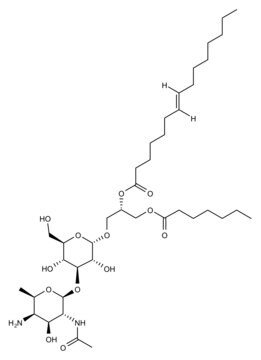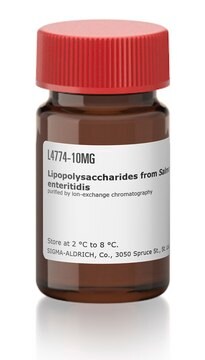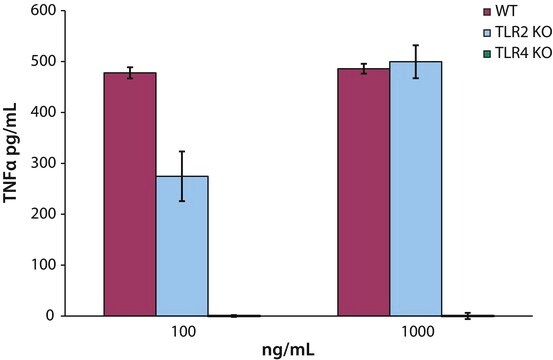L6261
Lipopolysaccharides from Salmonella enterica serotype minnesota
purified by phenol extraction
Synonym(s):
LPS
Sign Into View Organizational & Contract Pricing
All Photos(1)
About This Item
Recommended Products
biological source
Salmonella enterica (serotype minnesota)
Quality Level
form
lyophilized powder
purified by
phenol extraction
impurities
<3% Protein (Lowry)
solubility
water: soluble
storage temp.
2-8°C
Looking for similar products? Visit Product Comparison Guide
General description
Lipopolysaccharide (LPS) is the pyrogenic element arising from enterobacteria such as Escherichia coli and Salmonella enterica. It is an amphiphilic component containing polysaccharides and lipoidic material. LPS is present in the outer membrane of the cell wall of almost all Gram-negative bacteria.
Lipopolysaccharides (LPSs) are characteristic components of the cell wall of Gram-negative bacteria. LPS and its lipid A moiety stimulate cells of the innate immune system by the Toll-like receptor 4 (TLR4), a member of the Toll-like receptor protein family, which recognizes common pathogen-associated molecular-patterns (PAMPs).
Application
Lipopolysaccharides from Salmonella enterica serotype minnesota has been used:
- as a toll-like receptors (TLR ) agonist to induce tumor necrosis factor (TNF) α production in cereblon and Rabex-5 deficient mice in vivo,
- to study its effect on prostaglandin-E Synthase (PTGES) protein expression in monocyte-derived macrophages
- as a positive control for the maturation of monocyte-derived dendritic cells (MoDCs) to assess secretion of interleukin-10 and interferon (IFN)-γ
- as a supplement in Roswell park memorial institute (RPMI)media for culturing splenic B cells
- as a toll-like receptor 4 ligand to study its effect on the expression of the proallergic cytokines thymic stromal lymphopoietin (TSLP) and interleukin 33 (IL33) in H292 cells (pulmonary mucoepidermoid carcinoma cells)
Biochem/physiol Actions
Lipopolysaccharide (LPS) forms a permeability barrier around the cell surface to restrict the entry of toxic molecules such as antibiotics and bile salts. Owing to their external location, this endotoxin also plays a vital role in host-bacterium interactions by regulating host immune response. LPS is a microbe-associated molecular pattern (MAMP) that serves as a potent agonist for toll-like receptor 4 (TLR4)-MD2-CD14 receptor complex.
Other Notes
To gain a comprehensive understanding of our extensive range of Lipopolysaccharides for your research, we encourage you to visit our Carbohydrates Category page.
related product
Product No.
Description
Pricing
Signal Word
Danger
Hazard Statements
Precautionary Statements
Hazard Classifications
Acute Tox. 2 Oral
Storage Class Code
6.1A - Combustible acute toxic Cat. 1 and 2 / very toxic hazardous materials
WGK
WGK 3
Flash Point(F)
Not applicable
Flash Point(C)
Not applicable
Choose from one of the most recent versions:
Already Own This Product?
Find documentation for the products that you have recently purchased in the Document Library.
Customers Also Viewed
September R Mihaly et al.
PloS one, 9(4), e94982-e94982 (2014-04-17)
Macrophages play diverse roles in tissue homeostasis and immunity, and canonically activated macrophages are critically associated with acute inflammatory responses. It is known that activated macrophages undergo cell death after transient activation in some settings, and the viability of macrophages
Mohammed A Khedr et al.
European journal of gastroenterology & hepatology, 27(10), 1170-1174 (2015-07-07)
Hepatitis C virus (HCV) infection is a major health problem worldwide. Defective dendritic cell (DC) activation of T cells may underlie poor T-cell responsiveness in HCV infection. To evaluate the DCs' functions in chronically infected HCV patients and its correlation
David Millrine et al.
International immunology, 28(6), 307-315 (2016-02-13)
Thalidomide and its derivatives, collectively referred to as immunomodulatory drugs (IMiDs), are effective inhibitors of inflammation and are known to inhibit TLR-induced TNFα production. The identification of Cereblon as the receptor for these compounds has led to a rapid advancement
Blake Bertani et al.
EcoSal Plus, 8(1) (2018-08-02)
The cell envelope is the first line of defense between a bacterium and the world-at-large. Often, the initial steps that determine the outcome of chemical warfare, bacteriophage infections, and battles with other bacteria or the immune system greatly depend on
Christiane Eder et al.
Particle and fibre toxicology, 6, 27-27 (2009-10-20)
Cytochrome P450 monoxygenases play an important role in the defence against inhaled toxic compounds and in metabolizing a wide range of xenobiotics and environmental contaminants. In ambient aerosol the ultrafine particle fraction which penetrates deeply into the lungs is considered
Our team of scientists has experience in all areas of research including Life Science, Material Science, Chemical Synthesis, Chromatography, Analytical and many others.
Contact Technical Service




